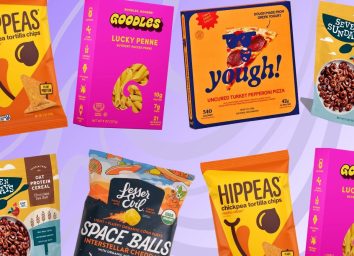Butter, Margarine, Ghee, or Vegan Butter—Which Is Healthier?

Maybe for you, it's that ooey-gooey butter that starts to melt on a hot piece of toast, the buttery creaminess on a cinnamon sugar sweet potato, or the buttery flavor baked into your favorite muffins. Either way, America loves butter—we also love its alternatives.
I often receive questions from my clients about whether butter or margarine is better for your health, and popular national brands seem to fuel this interest with new takes on ghee and plant-based, nondairy spreads. Let's cut through the confusion and dive into specifics about butter, margarine, ghee, and vegan butter to guide us on which buttery spread to throw in our grocery carts.
Butter

The beloved original, butter has remained a household name for what seems like centuries. This traditional, flavorful, dairy-based, semisolid fat is made by churning milk or cream and is often sold in sticks. Like many other oils, butter is high in fat and calories, coming in at almost 12 grams of total fat and 102 calories per tablespoon. It can also have over 80 grams of sodium per tablespoon when salted. Unfortunately, butter has 7 grams of saturated fat, which is 35% of the saturated fat daily value. The type of saturated fat in butter is predominantly palmitic acid, which tends to raise both total cholesterol and low-density lipoprotein (LDL) cholesterol and is associated with increased heart disease risk. Keep in mind that when butter is served in small balls or individual squares known as "pats," this could be as small as about a teaspoon and as much as 2 tablespoons in size.
Margarine

Often sold on the shelf alongside butter, margarine is commonly found in a tub but sometimes is sold in stick form, and does not have dairy as its first ingredient. It is suggested that when using tub margarine in place of stick butter or margarine, the risk of myocardial infarction—or heart attacks—decreases. Instead, a mixture of water and various plant-based oils take the lead, including palm, palm kernel, and soybean oils, as well as sometimes canola, coconut, and olive oils. In the past, margarines used to be a source of fully or partially "hydrogenated" fats resulting from the hydrogenation manufacturing process which adds hydrogen to an unsaturated compound. This made the margarine more solid at room temperature. However, the hydrogenation of oils is associated with less favorable health outcomes. Fortunately, hydrogenation is seldom seen in margarine products currently on the market.
The fat and calories are variable in margarines, hitting as low as about 35 calories with 4 grams total fat and 1 gram saturated fat per tablespoon to 70 calories with 8 grams total fat and 2.5 grams of saturated fat per tablespoon. Margarines also come in very low-calorie sprays, lending just enough spritz to lightly top fresh popcorn, put a glaze on roasted veggies, or to spray a pan for low- to medium-heat cooking.
Ghee

Ghee, a clarified butter, is very popular in Indian and Middle Eastern cuisine. Clarified butter is made by separating milk solids from butter, then keeping only the liquid butter fat that remains. This creates a more flavorful and shelf-stable butter product that has a higher smoke point of around 375 degrees or more for high-heat cooking techniques like sauteing, searing, or even frying.
While ghee may be terrific for food preparation and taste preference, it comes in even higher on fat, saturated fat, and calories per tablespoon at around 14 grams, 10 grams, and 120 calories, respectively. This puts one 1 tablespoon—the size of your thumb from knuckle to tip—at 50% of the saturated fat recommended daily value.
Vegan Butter

It's exciting to see the world of plant-based foods expand into so many corners of the grocery store, providing options for omnivores and herbivores alike. Vegan butter isn't such a foreign concept this side of 2014—when "Veganuary" was established amid an obvious shift in veganism's move to mainstream. Today, many brands are leveraging the word "vegan" to gain favor on the shelf.
Vegan butters are available somewhat equally on the market as tubs or spreads, and may have coconut, soybean, palm, canola, flax, or olive oils as the core ingredients. Many vegan butters also tend to add small amounts of protein from cashews, oats, faba beans, or pea protein to their recipe. Additionally, vegan butters register somewhere between 80 calories, 8 grams of total fat, and 4 grams of saturated fat to around 100 calories, 11 grams of total fat, and 5 grams of saturated fat per tablespoon.
The verdict
The most important differentiator in buttery spreads comes down to the number of calories, quantity of fat, and type of fat present—and compared to butter, margarine, and vegan butter, ghee has the highest in all three areas. Conversely, a carefully selected margarine can contain the least of all three.
Select a margarine whose primary ingredients are water and olive oil, avocado oil, flax oil, and/or canola oil for the best buttery spread ingredient list for your health. A margarine with these key ingredients will offer the ideal type of fat for supporting heart health and likely be lower in fat and calories to assist with weight control. Some of the healthiest margarine products to check out that align to this criteria include Smart Balance Buttery Spread with Extra Virgin Olive Oil Tub, I Can't Believe It's Not Butter! Spray, or Earth Balance Organic Buttery Spread Tub.









